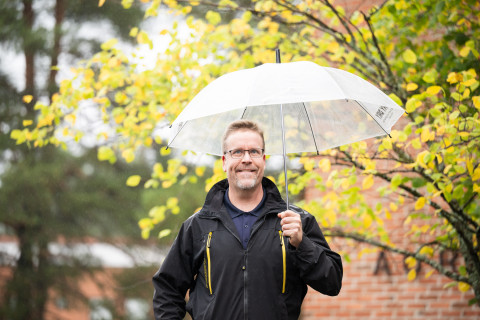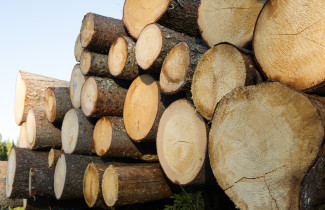Established under an endowment from the City of Joensuu, the professorship in wood products technology pertains to the Sustainable Technologies programme at the University of Eastern Finland.
Wood construction adds productivity, well-being and perhaps even more years to life
Professor of Wood Products Technology Henrik Heräjärvi moved to the University of Eastern Finland after working for the Natural Resources Institute Finland, formerly known as the Finnish Forest Research Institute, for a quarter of a century. He knows the university well, thanks to having studied at the University of Joensuu, and having held fixed-term professorships in wood technology and wood materials science.
The field of wood products technology encompasses the basic wood products industries, such as sawmills and plywood mills, the wood products refining industries, and machinery and equipment manufacturing. Wood construction is currently attracting international interest due to, e.g., its low climate load.
“The construction sector is the most important individual client of the forest bioeconomy, with about 70% of wood products going into the construction sector value chains. Wood products are manufactured from sawlogs, which hold the main financial incentive within forestry. The major significance of wood construction also influenced the definition of my role,” Heräjärvi says.
Wood construction is not just about load-bearing structures and external cladding. Wood products used in interior design, and their effects on well-being, are of great interest across the world. At the University of Eastern Finland, research into the field is expected to expand.
“I see findings emerging from this field as a huge marketing advantage for wood. For instance, office work can be significantly more productive in facilities that are furnished with materials that enhance psychophysical well-being. In Finland, research into the topic remains scarce, but in Japan, for example, things are further along.”
“This is a hugely interesting theme. Wood and other natural materials, as well as biophilic surfaces mimicking them, may have significant health effects through, for example, stress reduction,” Heräjärvi says.
Wood-based insulation solutions face many expectations
The construction sector is already witnessing a paradigm shift from new construction to maintenance and renovation.
“Renovation business will increase further, either through guidance or through incentives,” he says.
The conditions in which buildings are used are changing with the climate, which sets new requirements for wooden parts regarding their resilience to moulds, decay fungi and weather. The fact that toxins-containing preservatives cannot be added to wood and paints like in the old days creates an additional challenge.
“Here in Finland, we’ve been lucky to have a cold period of six months, keeping decay and mould fungi at bay. The situation is changing, as the inactive period of these organisms may already have been halved. In other words, the risk period is longer and, to avoid future problems, both new construction and renovation solutions need to react,” says Heräjärvi.
Efficiency in the use of all materials, including wood, should be increased, and waste avoided. Current building stocks and future facility needs should be systematically reconciled at municipal level, for example, and options for renovating old buildings should always be explored first, before building new ones.
For the environment, building something new is almost always the worst solution.
Henrik Heräjärvi
Professor
Wood-based insulation solutions face many expectations. According to an EU initiative, some 30 million European homes must be energy renovated, i.e., better insulated, by 2030. Financial support for this has been reserved, but implementation remains open.
“Almost 98% of the insulation materials used in Europe are not renewable. If the extensive European Renovation Wave campaign is carried through without renewable insulation materials finding their way to the market, the profits will be collected by the stone, glass wool and plastics industries,” Heräjärvi notes.
“Wood-based insulation materials hold, thus, huge market potential in Europe’s current insulation market of around 15 billion euros. This market is bigger than the export value of the entire Finnish forest industries. Carbon molecules have the same life cycle in wood-based insulation materials as in sawn timber, which would also affect the carbon storage accounting of the building stock.
According to Heräjärvi, this, too, is a reason for technology students to be involved in solving challenges that are truly global.
“Our Master’s Degree Programme in Technology revolves around some major issues, and students have made a smart choice,” he says.
“Our transition towards a sustainable society where habits relating to materials, recycling processes and consuming are different from what they used to be, is still incomplete. Our students will be at the forefront of solving issues related to resource-smart processes, while providing societies with sustainable solutions.”
HENRIK HERÄJÄRVI
Professor of Wood Products Technology, 1 August 2023–, University of Eastern Finland
Master of Science (Agriculture and Forestry), University of Joensuu, 1998
Doctor of Science (Agriculture and Forestry), University of Joensuu, 2003
Title of Docent in Wood Technology, University of Eastern Finland, 2007–
Specialist Vocational Qualification in Product Development, City of Helsinki Education Division, 2012
Key roles
Senior Scientist, Programme Director (Finnish Forest Research Institute, Natural Resources Institute Finland, 1998 –2023)
Professor (fixed term) of Wood Technology (University of Joensuu, 2004–2006)
Professor (fixed term) of Wood Materials Science (University of Eastern Finland, 2016–2018)




